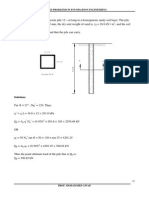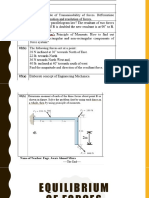Sand Drains
Sand Drains
Uploaded by
Melissa SammyCopyright:
Available Formats
Sand Drains
Sand Drains
Uploaded by
Melissa SammyOriginal Description:
Copyright
Available Formats
Share this document
Did you find this document useful?
Is this content inappropriate?
Copyright:
Available Formats
Sand Drains
Sand Drains
Uploaded by
Melissa SammyCopyright:
Available Formats
Rate of Foundation Settlement 377
10.14.3 Determination of initial excess pore water pressure values
For consolidation problems, Uj can at any point be 'taken as
equal to the increment of the total major principal stress at that point. For
two- and problems Uj must be obtained from the formula:
Uj = B[Ll0"3 +A(LlO"I - Ll0"3)]
As the clay is assumed saturated, B= 1.0.
10.15 Sand drains
Sometimes the natural rate of consolidation of a particular soil is too slow,
particularly when the layer overlies an impermeable material and, in order
that the structure may carry out its intended purpose, the rate of consolida-
tion must be increased. An example of where this type of problem can occur is
an embankment designed to carry road traffic. It is essential that most of the
settlement has taken place before the pavement is constructed if excessive
cracking is to be avoided.
From the Model Law of Consolidation it is known that the rate of
dation is proportional to the square of the drainage path length. Obviously
the consolidation rate is increased if horizontal, as well as vertical, drainage
paths are made available to the pore water. This can be achieved by the
installation of a system of sand drains, which is essentially a set of vertical
boreholes put down through the layer, ideally to a firmer material, and then
backfilled with porous material, such as a suitably graded sand. The method
was first used across a marsh in California and is described by porter (1936).
A tpical arrangement is shown in Fig. 10.18a. There are occasions when
the sand drains are to puncture through an impermeable layer when
there is a pervious layer beneath it. This creates vertical drainage, as
well as lateral, and results in a considerable speeding up of construction.
Diameter of drains: vary from 300 to 600 mm. Diameters less than 300 mm
are generally difficult to install unless the surrounding soil is considerably
remoulded.
r- __ Possible overload
'" ',> >
/ Permanent fill
, ... ". /," /,.. " .. n: ... po
(a)
Fig, 10.18 Typical sand drain arrangements.
Permeable
(b)
Impermeable
layer
," "
378 Elements ef Soil Mechanics
(a) Square (b) Triangular
Fig. 10.19 Popular arrangements of sand drains.
Spacing of drains: depends upon the type of soil in which they are placed.
Spacings vary between 1.5 and 4.5 m. Sand drains are effective if the spacing,
a, is less than the thickness of the consolidating layer, 2H.
Arrangement ofgrid: sand drains are laid outin either square (Fig. 1O.19a)
or triangular (Fig. IO.l9b) patterns. For triangular arrangements the grid
forms a series of equilateral triangles the sides of which are equal to the drain
spacing. Barron (1948) maintains that triangular spacing is more economical.
In his paper he solved the consolidation theory for sand drains.
Depth of sand drains: dictated by subsoil conditions. Sand drains have been
installed to depths of up to 45 m.
Type of sand used: should be clean and able to carry away water yet not
permit the fine particles of soil to be washed in.
Drainage blanket: after drains are installed a blanket of gravel and sand from
0.33 to 1.0m thick, is spread over the entire area to provide lateral drainage at
the base of the fill.
Overfill or surcharge: often used in conjunction with sand dfains. It consists
'"
of extra fill material placed above the permanent fill to accelerate consolida-
tion. Once piezometer measurements indicate that consolidation has become
slow this surcharge is removed.
Strain effects: although there is lateral drainage, lateral strain effects are
assumed to be negligible. Hence the consolidation of a soil layer in which
sand drains are placed is still obtained from the expression:
Pc = m
v
dp2H
Consolidation theory
The three-dimensional consolidation equation is:
where Ch = coefficient of consolidation for horizontal drainage (when it can be
measured: otherwise use c
v
).
The various co-ordinate directions of the equation are shown in Fig. 10.20.
The equatiom can be solved by finite differences.
Rate of Foundation Settlement 379
/Dia
as
0
z
00
00
.4
CD
c
-
. of drain (2r)
Fig. 10.20 Coordinate directions.
Equivalent radius
The effect of each sand. drain extends to the end of its equivalent radius, which
differs for square and triangular arrangements (see Fig. 10:19).
For a square system:
Area of square enclosed by grid = a
2
Area of equivalent circle of radiusR = a
2
i.e. 1l"R
2
= a
2
or R=O.564a.
Fora triangular system:
A hexagon is formed by bisecting the various grid lines joining adjacent
drains (Fig. 10.21). A typical hexagon is shown in the figure from which it is
seen that the base of triangle ABC, i.e. the line AB, = a/2.
Now
aa
= AB tan LCBA = 2tan 30 = 2J3
hence:
. I a a a
2
Area of tnangle ABC = 2x 2x 2J3 = 8J3
Fig. 10.21 Equivalent radius: triangular system.
380 Elements of Soil Mechanics
So that:
, a
2
Total area of the hexagon = 12 x 8y'3= 0.865a
2
Radius of the equivalent circle, R = 0.525a
Determination of consolid4tion rates from curves
Barron has produced curves which give the relationship between the degree of
consolidation due to radial flow only, Ur, and the corresponding radial time
factor, T
r
T _ Ch
t
r - 4R2
where t = time considered.
These curves are reproduced in Fig. 10.22 and it can be seen that they
involve the use of factor n. This factor is simply the ratio of the equivalent
radius to the sand drain radius.
R
n = - and should lie between 5 to 100
r
To determine U (for both radial and vertical drainage) for a particular time, t,
the procedure becomes:
(i) Determine U
z
from the normal consolidation curves of U
z
against T
z
(Fig. 10.4):
Cyt
T
z
= H2 where H = vertical drainage path
(ii) Determine U
r
from Barron's curves of U
r
against T
r
.
(iii) Determine resultant percentage consolidation, U, from:
1
U = 100 - 100 (100 - Uz)(lOO - Ur)
1---
.
-
-......:::
r---..
........
r-- ...
k
......
........
"
'"
"-
r-.
r-.
'\.
i"'\.
r-..
\
1\
t'-.....
"
t--.
o
10
20
;g
30
c: 40
o
50
:2
g 60
70
()
80
90
100
0.004 0.01 0.04 0.10 0.40 1.0
Time factor, T,
Fig. 10.22 Radial consolidation rates (after Barron, 1948).
Rate of Foundation SetUement 331
Smear effects
The curves in Fig. 10.22 are for idealised drains, perfectly installed, clean and
working correctly. Wells are often installed by driving cased holes and then
backfilling as the casing is withdrawn, a procedure that causes distortion and
remoulding in the adjacent soil. In varved clays (clays with sandwich type
layers of silt and sand within them) the finer and more impervious layers are
dragged down and smear over the more pervious layers to create a zone of
reducedpenneability around the perimeter of the drain. This smeared zone
reduces the rate of consolidation, and in situ measurements to .check on the
estimated settlement rate are necessary on all but the smallest of jobs.
Effectiveness of sand drains
Sand drains are particularly suitable for soft clays but have little effect on soils
with small primary but large secondary effects, such as peat. See Lake (1963).
EXAMPLE 10.7
A soft clay layer, m
v
= 2.5 x 10-
4
m
2
/kN; Cv = 0.187m
2
/month, is 9.2m thick
and overlies impervious shale. An embankment, to be constructed in six
months, will subject the centre of the layer to a pressure increase of 100 kN/m
2
.
It is expected that a roadway will be placed on top of the embankment one
year after the start of construction and maximum allowable settlement after
this is to be 25 mm.
Determine a suitable sand drain system to achieve the requirements.
Solution
2.5
Pc = mvdp2H = 10000 x 100 x 9.2 x 1000 = 230mm
,J
therefore, minimum settlement that must have occurred by the time the
roadway is constructed == 230 - 25 = 205 mm. i.e.
205
U = 230 = 90 per cent
Assume that settlement commences at half the construction time for the
embankment. Then time to reach U = 90 per cent = 12 - = 9 months.
T = cvt = 0.187 x 9 = 0020
z . H2 9.22 .
From Fig. 10.4 U
z
= 16 per cent.
Try 450 mm (0.45 m) diameter drains in a triangular pattern.
Select n = 10. Then
R/r = 10 and R = 2.25m
hence
2.25
a = 0.525 = 4.3m
382 Elements of Soil Mechanics
Select a grid spacing of 3m.
R = 0.525 x 3 = 1.575m
_ 1.575 _ 7
n - 0.225-
Cyt 0.187 x 9
T
r
= 4R2 = 4 X 1.5752 = 0.169
(Note that no value for Ch was
given so C
v
must be used)
From Fig. 10.22, U
r
= 66 per cent.
U = 100 1 ~ (100 - 16)(100 - 66)
= 71.4 per cent, which is not sufficient
Try a=2.25m; R= 1.18m; n= 5.25.
T = 0.187 x 9 = 0 302
r 4 X 1.18
2
'
From graph, U
r
= 90 per cent.
Total consolidation percentage = 100 - 1 ~ (100 -116)(100 - 90)
= 91.6%
The arrangement is satisfactory.
Obviously no sand drain system could be designed as quickly as this. The
object of the example is simply to illustrate the method. The question of
installation costs must be considered and several schemes would have to"'be
closely examined before a final arrangement could be decided upon.
Exercises
EXERCISE 10.1
A soil sample in an oedometer test experienced 30 per cent primary consolida-
tion after 10 minutes. How long would it take the sample to reach 80 per cent
consolidation?
Answer 80min
EXERCISE 10.2
A 5m thick clay layer has an average Cy value of 5.0 x 10-
2
mm
2
/min. If the
layer is subjected to a uniform initial excess pore pressure distribution,
determine the time it will take to reach 90 per cent consolidation (i) if drained
on both surfaces and (ii) if drained on its upper surface only.
Answer (i) 200 years, (ii) 800 years
Rate of Foundation Settlement 383
EXERCISE 10.3
In a consolidation test the following readings were obtained for a pressure
increment:
Sample thickness (mm)
16.97
16.84
16.76
16.61
16.46
16.31
16.15
16.08
16.03
15.98
15.95
Time (min)
o
I
4
1
4
9
16
25
36
49
64
81
(i) Determine the coefficient of consolidation of the sample.
(ii) From the point for U = 90 per cent on the test curve, establish the point
for U = 50 per cent and hence obtain the test value for tso. Check your
value from the formula
TsoH
2
tso=--
Cv
Answer Cy = 1.28 mm
2
/min, tso = 10.2min
EXERCISE 10.4
A sample in a consolidation test had a mean thickness of 18.1 mm during
a pressure increment of 150 to 290 kN/m
2
. The sample achieved 50 per cent
consolidation in 12.5 min. If the initial and final void ratios for the increment
were 1.03 and 0.97 respectively, determine a value for the coefficient ofperme-
ability of the soil.
Answer k = 2.78 X 10-
6
mm/min
EXERCISE 10.5
A 2m thick layer of clay, drained at its upper only, is subjected to a
triangular distribution of initial excess pore water pressure varying from
1000 kN/m
2
at the upper surface to 0.0 at the base. The Cy value of the clay is
1.8 x 10-
3
m
2
/month. By dividing the layer into 4 equal slices, determine,
numerically, the degree of consolidation after 4 years.
Note If the total time is split into increments, r = 0.494.
Answer U = 15 per cent
You might also like
- Ocean Wave Hydrodynamics Tutorial ProblemsNo ratings yetOcean Wave Hydrodynamics Tutorial Problems6 pages
- Book - Chapter - 6-Stress Distribution in Soil Due To Surface Load67% (3)Book - Chapter - 6-Stress Distribution in Soil Due To Surface Load34 pages
- 1.chapter 2: Lateral Earth Pressures and Retaining WallsNo ratings yet1.chapter 2: Lateral Earth Pressures and Retaining Walls20 pages
- Chapter 6: Highway Drainage System and DesignNo ratings yetChapter 6: Highway Drainage System and Design36 pages
- Correlation Between Effective Cohesion and Plasticity Index of ClayNo ratings yetCorrelation Between Effective Cohesion and Plasticity Index of Clay6 pages
- Geotechnical Engineering II: Shear Strength of SoilNo ratings yetGeotechnical Engineering II: Shear Strength of Soil184 pages
- Ch7 Lateral Earth Pressure Theories (407-440)No ratings yetCh7 Lateral Earth Pressure Theories (407-440)34 pages
- Distributing The Load of Bridges Over The GirdersNo ratings yetDistributing The Load of Bridges Over The Girders28 pages
- Chapter3-Bearing Capacity of FoundationNo ratings yetChapter3-Bearing Capacity of Foundation12 pages
- Topic 3 - Flexible Pavement Stress Analysis100% (1)Topic 3 - Flexible Pavement Stress Analysis22 pages
- Lesson 1 Shallow Foundation-Bearing Capacity 2No ratings yetLesson 1 Shallow Foundation-Bearing Capacity 243 pages
- Numerical Methods and Implementation in Geotechnical Engineering – Part 1From EverandNumerical Methods and Implementation in Geotechnical Engineering – Part 1No ratings yet
- Ttconnect Requirements For Completion of Online Ttconnect ID ETax & TTBizlink Registrations ListingNo ratings yetTtconnect Requirements For Completion of Online Ttconnect ID ETax & TTBizlink Registrations Listing1 page
- Truss Bridges Are The Oldest Known ModernNo ratings yetTruss Bridges Are The Oldest Known Modern5 pages
- ANSYS Fluent Battery Module Manual.1-13 PDFNo ratings yetANSYS Fluent Battery Module Manual.1-13 PDF13 pages
- Date Sheet For DAE Pre-Board Examination 2017 (Practical Paper)No ratings yetDate Sheet For DAE Pre-Board Examination 2017 (Practical Paper)3 pages
- Arup Paper On CFD For Tsinghua University CFD Seminar1-45No ratings yetArup Paper On CFD For Tsinghua University CFD Seminar1-4510 pages
- DIN 3021-3_2016-11_aktuell_-_current.de.englishNo ratings yetDIN 3021-3_2016-11_aktuell_-_current.de.english13 pages
- Science 7 3rd Quiz 1 Motion in One DirectionNo ratings yetScience 7 3rd Quiz 1 Motion in One Direction3 pages
- PDF (Ebook) Magnetic and Electric Resonance by Marian Apostol ISBN 9781527514942, 1527514943 download100% (3)PDF (Ebook) Magnetic and Electric Resonance by Marian Apostol ISBN 9781527514942, 1527514943 download71 pages
- 03 - 120803 Hot Melt Extrusion With BASF Pharma Polymers100% (2)03 - 120803 Hot Melt Extrusion With BASF Pharma Polymers201 pages
- DHW Usage Factor Demographic Characteristics Occupancy: Entering Water Temp Faucet Delivery Temp Delta TNo ratings yetDHW Usage Factor Demographic Characteristics Occupancy: Entering Water Temp Faucet Delivery Temp Delta T6 pages
- EN ISO 20932-1 Knitted Fabric - Method A - Fixed Load (KGF) - Without Pretension +with Force DecayNo ratings yetEN ISO 20932-1 Knitted Fabric - Method A - Fixed Load (KGF) - Without Pretension +with Force Decay2 pages
- Development of Relationship Between Saturation Flow and Capacity of Mid Block Section of Urban Road - A Case Study of Ahmedabad CityNo ratings yetDevelopment of Relationship Between Saturation Flow and Capacity of Mid Block Section of Urban Road - A Case Study of Ahmedabad City6 pages
- Book - Chapter - 6-Stress Distribution in Soil Due To Surface LoadBook - Chapter - 6-Stress Distribution in Soil Due To Surface Load
- 1.chapter 2: Lateral Earth Pressures and Retaining Walls1.chapter 2: Lateral Earth Pressures and Retaining Walls
- Correlation Between Effective Cohesion and Plasticity Index of ClayCorrelation Between Effective Cohesion and Plasticity Index of Clay
- Geotechnical Engineering II: Shear Strength of SoilGeotechnical Engineering II: Shear Strength of Soil
- Numerical Methods and Implementation in Geotechnical Engineering – Part 1From EverandNumerical Methods and Implementation in Geotechnical Engineering – Part 1
- Ttconnect Requirements For Completion of Online Ttconnect ID ETax & TTBizlink Registrations ListingTtconnect Requirements For Completion of Online Ttconnect ID ETax & TTBizlink Registrations Listing
- Date Sheet For DAE Pre-Board Examination 2017 (Practical Paper)Date Sheet For DAE Pre-Board Examination 2017 (Practical Paper)
- Arup Paper On CFD For Tsinghua University CFD Seminar1-45Arup Paper On CFD For Tsinghua University CFD Seminar1-45
- PDF (Ebook) Magnetic and Electric Resonance by Marian Apostol ISBN 9781527514942, 1527514943 downloadPDF (Ebook) Magnetic and Electric Resonance by Marian Apostol ISBN 9781527514942, 1527514943 download
- 03 - 120803 Hot Melt Extrusion With BASF Pharma Polymers03 - 120803 Hot Melt Extrusion With BASF Pharma Polymers
- DHW Usage Factor Demographic Characteristics Occupancy: Entering Water Temp Faucet Delivery Temp Delta TDHW Usage Factor Demographic Characteristics Occupancy: Entering Water Temp Faucet Delivery Temp Delta T
- EN ISO 20932-1 Knitted Fabric - Method A - Fixed Load (KGF) - Without Pretension +with Force DecayEN ISO 20932-1 Knitted Fabric - Method A - Fixed Load (KGF) - Without Pretension +with Force Decay
- Development of Relationship Between Saturation Flow and Capacity of Mid Block Section of Urban Road - A Case Study of Ahmedabad CityDevelopment of Relationship Between Saturation Flow and Capacity of Mid Block Section of Urban Road - A Case Study of Ahmedabad City


































































































